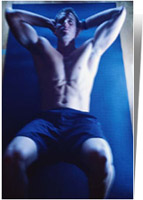10 Worst Ab Exercises
by Phil Kaplan - Special For eDiets
From
eDiets - The online diet, fitness, and healthy living resource
A muscular man with a wide waist approaches the
dumbbell rack. He picks up two 25-pound dumbbells, holds them at his sides and
begins a set of side bends. First he bends to the left, then to the right.
 His goal, we can guess, is to reduce his waist. Unfortunately, his approach
might actually bring him a need for larger belts and pants sizes.
His goal, we can guess, is to reduce his waist. Unfortunately, his approach
might actually bring him a need for larger belts and pants sizes.
While quests for muscular arms, shoulders and
torsos have long been a priority, there's no more sought after physical
attribute today than the "six-pack." If you were to form your opinion of
Americans based solely on TV infomercials, you’d surmise that Americans
want two things, great sex and great abs.
The six-pack, more accurately referred to as an
eight-pack is the result of a well-developed rectus abdominus being made
visible by a low level of bodyfat. It's not six or eight different muscles, but
rather a single muscle separated into sections by the linea alba -- which runs
vertically separating the rectus abdominus into a right and left half, and
tendinous inscriptions -- that run horizontally across the muscle.
While the number of people seeking great abs
continues to escalate, so too does the proliferation of flawed ab training
advice leading to mistakes destined to limit results, or in some cases,
increase risk of injury.
One of the most integral parts of a valuable
abdominal exercise routine is the involvement of the core muscles, and far too
many offerings completely neglect those vital muscles. The core muscles, such
as the deep-lying transversus, act to stabilize, balance and support real world
movement. The transversus acts as a sort of an internal corset and is a primary
contributor to the “flat tummy.” A focus on the external muscles with
neglect of the core musculature can lead to an appearance of abdominal
distension (expanded).
Wayne Westcott, PhD., Fitness Research Director
at the South Shore YMCA in Boston, has two primary concerns when considering
the design of an abdominal exercise routine. According to Westcott, “in a
routine where any abdominal exercise movement places stress on the back, the
risks outweigh the potential benefits. In a nation where 80 percent of the
population has back problems, caution is required. Secondly, anything that
doesn't involve a range of movement of the abdominal muscles against a
reasonable resistance is not going to be effective.”
 In
constructing your abdominal program, you want to make certain you limit the
exercise movements to those that are safe as well as effective. Peter Francis,
Ph.D., of the Biomechanics Lab at San Diego State University, conducted a
valuable study sanctioned by the American Council on Exercise (ACE) in order to
measure the effectiveness of some of the ab promises. Francis compared 13
common abdominal exercise alternatives. Ab crunches on a stability ball proved
to be the most effective and safe. This article, however, is not about the
best, but rather to provide you enough information so you avoid making
mistakes. In
constructing your abdominal program, you want to make certain you limit the
exercise movements to those that are safe as well as effective. Peter Francis,
Ph.D., of the Biomechanics Lab at San Diego State University, conducted a
valuable study sanctioned by the American Council on Exercise (ACE) in order to
measure the effectiveness of some of the ab promises. Francis compared 13
common abdominal exercise alternatives. Ab crunches on a stability ball proved
to be the most effective and safe. This article, however, is not about the
best, but rather to provide you enough information so you avoid making
mistakes.
The study by Francis ranked the exercises in
order, and some of the best-selling infomercial products, those that make the
boldest claims, landed at the bottom of the list. It’s clear that the
solution lies not so much in a piece of equipment or machinery as it does in
knowledge and application of a sound technology. So, in order to help you veer
away from ineffective ab routines, here are the “10 Worst!”
1. Electronic Ab Stimulation
You can’t turn on the television on a
Saturday morning without being besieged with offerings for electronic ab
stimulators. The premise is, you switch on the power, and your body performs
the equivalent of 600 or 800 sit-ups in an hour. Does the premise hold water?
Respected researcher, Dr. John Porcari, a professor in the Department of
Exercise and Sport Science at University of Wisconsin at LaCrosse, explains
that while in theory there might be some validity to an approach including
electronic stimulation, these devices are certainly not the six-pack solution
the ads promise.
According to Porcari, who conducted a study on
the value of EMS application, “All these machines are doing is telling
your muscles to contract, causing what often equates to a painful contraction
without fully activating all the neural and chemical signals that contribute to
muscular development.” His study asked 16 subjects, 9 women and 7 men to
follow the recommended protocol included with the standard EMS unit. The group
was divided into a subgroup of people who actually applied the electrical
impulses, and a control group that was hooked up to absolutely no electric
current.
The results? There wasn’t any difference
between the groups in terms of fat loss, muscle development or muscle
definition. If you want to make the best use of electricity in your ab program,
use it to activate a CD player, while motivational music sets the background
for a sound abdominal routine.
2. Bent Over Twist
Here’s another infamous exercise that is
used to “work the waistline.” The exerciser holds a light bar or a
broomstick behind his neck with his arms outstretched, bends forward from the
waist so his upper body is parallel with the ground and begins twisting from
left to right. While this movement does require some involvement of the
obliques, the primary muscles at work are the spinal erectors, straining to
maintain force in order to keep your body flexed and stable at that 90-degree
angle. A lot of strain is placed on ligaments and connective tissue. Gradual
wearing away of soft tissue can lead to serious back problems.
3. Straight-Legged Sit-Ups
Perhaps in high school gym class you had someone
hold your feet with your knees locked, kept your legs fixed along the floor and
you performed a number of sit-ups. Thankfully, a high school student’s
body is far more forgiving of exercise mistakes than an adult’s.
Performing straight-legged sit-ups with your feet stabilized is another way to
put undue pressure on the lower spine, and the jerky movement required to lift
from the floor can result in injury. The better abdominal exercises have the
feet unsupported, knees bent and replace the jerky muscle contraction with a
slow and gradual curling movement.
 4. Roman Chair Sit-Ups 4. Roman Chair Sit-Ups
This is a movement where, in practice, the
exerciser’s thighs are in a position parallel with the ground. The upper
body, beginning at 90-degree flexion, lowers down backward, often beyond the
point where the spinal vertebrae are aligned as they are in a relaxed standing
position. While you’ll definitely “feel it” in the abdominal
region, due to the range of motion resulting in a full extension of the rectus
abdominus, much of the work on the return movement is performed by the hip
flexors, muscles that have nothing to do with abdominal development.
There are high compressive forces being placed
upon the spine when it flexes or extends beyond safe limits. The use of a
weight held behind the head or on the chest further increases the compression,
increasing risk of injury.
5. Two-Dumbbell Side Bend
Earlier, I mentioned a muscular man doing side
bends. While side bends performed properly can target the obliques, holding two
dumbbells negates the resistance. In other words, as you return from a position
where you’re bent to the right side, the dumbbell in the left hand is
actually assisting, adding momentum.
There is also some question both about the value
of performing side bends in terms of the capacity to increase oblique size, and
about the spinal safety of repetitive side bending against resistance. A common
mistake lies in believing that side bends will reduce the waist. Without a
concern for adequate nutrition, aerobic exercise and resistance exercise for
all major muscle groups, side bends will not have any effect on reducing fat.
If you develop a muscle underneath subcutaneous fatty deposits, you may
actually INCREASE your waist size.
6. Straight Leg Double Leg Raises
Whether you perform this exercise on the floor or
on the end of a bench, the abdominal muscles have little actual involvement.
The majority of work is performed by the psoas muscles. The psoas muscles
attach at the lumbar spine and the femur, thus the movement places unnecessary
stress on the lumbar spine, low back discs and spinal ligaments. According to
Damian Stephens, Instructor for the National Council of Strength & Fitness
in Miami, In order to effectively, safely, and optimally target the abdominals,
the exerciser should maintain a posterior pelvic tilt.
"In a straight leg, double leg raise, the pelvis
assumes a position where the pull of the psoas increases the lordodic curve at
L5 S1, the place most back problems occur in the general population."
7. Ab Rocker
This is one of the devices sold via infomercials
with creative visuals supporting promises of abdominal improvement. As most
infomercial products, it is presented as a quick, easy way to achieve a result.
The premise is that a simple rocking motion can be used to “smooth”
the tummy and waistline. Of the 13 exercises ranked in the study by Peter
Francis mentioned earlier, the abdominal exercise applying the ab rocker ranked
last. It proved to be 80 percent less effective than the traditional abdominal
crunch.
8. The Ab Wheel
Many ab devices in the last couple years have
been developed to replicate the age-old movement performed by rolling a wheel
out in front of you in order to target “those stubborn abs.” The
infomercials usually include testimonials from people who explain that they
“really feel it.” It’s unfortunate that “feeling it”
in the abs isn’t always in direct correlation with stimulating results.
With the “wheel” or “rolling movement,” little range of
motion is actually undertaken by the abs.
While the “ab wheel” might have its
place in an advanced routine for a conditioned athlete, less conditioned users
often report low back pain. If shoulder and upper back strength are limited,
and the core abdominal muscles are not developed, this movement can put the
lower back in a precarious position.
9. Improper Use Of The Nautilus Abdominal
Machines
The Nautilus abdominal crunch machine has been a
favorite of serious exercisers for years. Both the upper and lower body are in
motion during the movement with the lumbar and thoracic spine acting as the
central pivot point. The problem here lies not with the machine itself, but
with the room for error in positioning and movement. While it can provide an
effective ab workout, if the seat is not adjusted properly or the body is not
properly aligned, flexion occurs from the hip joint asking the hip flexors to
do most of the work and putting pressure on the discs of the lumbar spine.
10. Seated Spinal Twist Machine
These machines, found in well-equipped health
clubs, allow the exerciser to flex the lumbar spine while twisting at the
waist. This results in a great deal of pressure placed upon the spinal
ligaments. The obliques can be worked with abdominal crunching or curling
movements with far greater effectiveness and with greater safety.
You won’t find any shortage of devices
making promises of a flat tummy or great abs. There is an abundance of advice
related to abdominal movements circulating through word-of-mouth wisdom on the
workout floors of health clubs. It doesn’t matter if it’s an ab
pusher, ab wrap or abba-dabba-do. If it doesn’t fit within the realm of
safe and effective exercise, it hasn’t any place in your exercise
routine.
* * *
San Diego State University/ACE Abdominal Study
Results
For strengthening the rectus abdominus, the 13
exercises were ranked from most to least effective:
1. Bicycle maneuver
2. Captains chair
3.
Crunches on exercise ball
4. Vertical leg crunch
5. Torso track
6.
Long arm crunch
7. Reverse crunch
8. Crunch with heel push
9. Ab
roller
10. Hover
11. Traditional crunch
12. Exercise tubing
pull
13. Ab rocker
For strengthening the obliques, the 13 exercises
were ranked most to least effective:
1. Captain’s chair
2. Bicycle
maneuver
3. Reverse crunch
4. Hover
5. Vertical leg crunch
6.
Crunch on exercise ball
7. Torso track
8. Crunch with heel push
9.
Long arm crunch
10. Ab roller
11. Traditional crunch
12. Exercise
tubing pull
13. Ab rocker
Phil Kaplan has developed a reputation as one
of the world’s most in demand fitness professionals. Find more information
at www.philkaplan.com. |